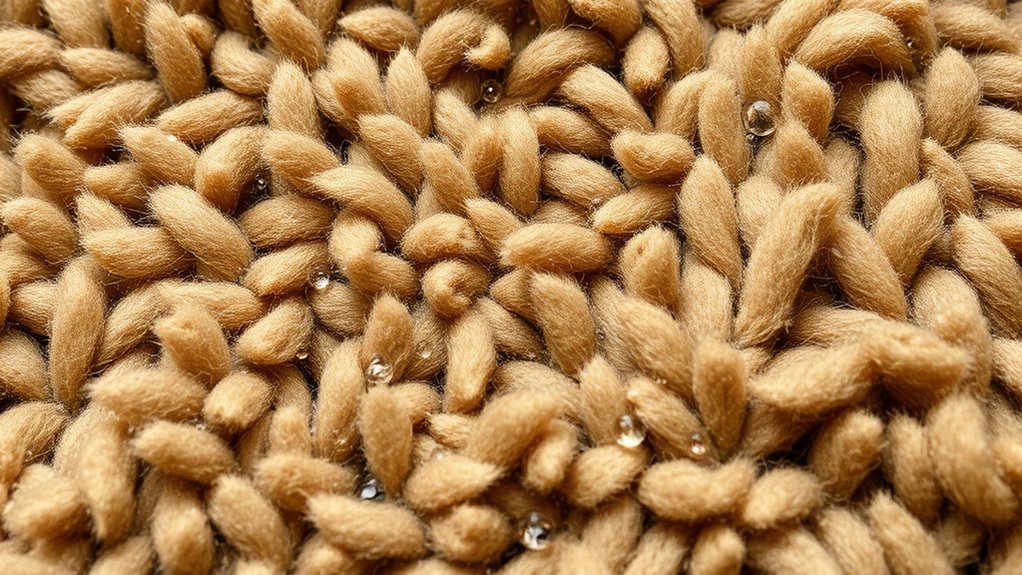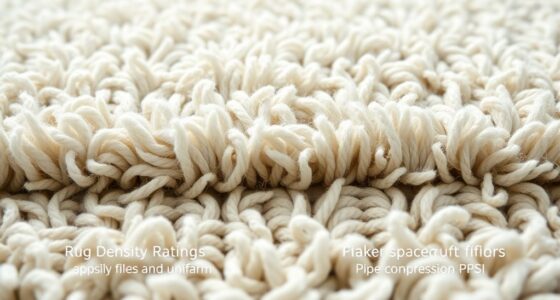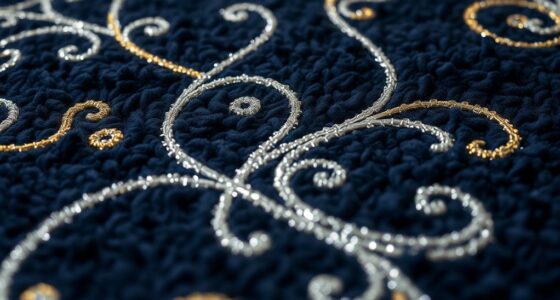Lanolin, a natural wax on wool fibers, acts as an effective barrier against stains by repelling moisture and preventing spills from soaking in. Its hydrophobic properties cause liquids to bead up, making cleanup easier and protecting the fibers from damage. Unlike synthetic treatments, lanolin is eco-friendly and helps maintain wool’s durability and appearance. To discover how this natural process works and ways to enhance it, keep exploring the science behind wool’s stain resistance.
Key Takeaways
- Lanolin forms a hydrophobic waxy barrier on wool fibers, preventing deep stain penetration and facilitating easier stain removal.
- Its natural oil composition causes liquids to bead, reducing absorption and spreading on wool surfaces.
- Lanolin’s protective layer maintains wool’s flexibility and durability, enhancing stain resistance over time.
- Proper maintenance, like gentle cleaning and prompt spill blotting, preserves lanolin’s stain-repellent properties.
- Natural wool protectants containing lanolin are eco-friendly, non-toxic, and support sustainable stain resistance solutions.
The Composition and Role of Lanolin in Wool Fibers
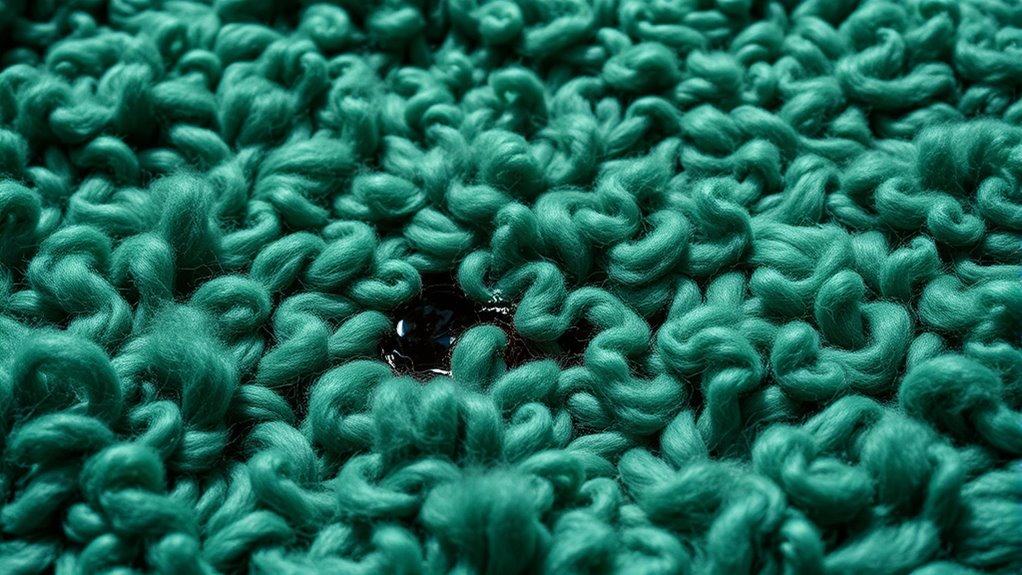
Lanolin is a natural waxy substance found on the outer surface of wool fibers, playing an essential role in protecting the wool. Its chemistry involves complex mixtures of esters, fatty acids, alcohols, and hydrocarbons, making it highly effective at repelling water and dirt. This protective layer forms naturally during sheep’s wool production, acting as a barrier against environmental elements. When you handle wool, lanolin helps reduce moisture absorption and shields fibers from damage. Its unique composition ensures that wool remains resilient and durable, while also maintaining flexibility. By understanding lanolin chemistry, you recognize its indispensable role in wool fiber protection, which contributes to the natural stain resistance and longevity of wool rugs. This intrinsic feature keeps wool fibers healthier and better equipped to withstand everyday wear, especially when combined with protective properties. The water-repellent qualities of lanolin are crucial in maintaining wool’s natural resistance to stains and water-based damage.
How Lanolin Creates a Protective Barrier Against Stains

The natural waxy coating on wool fibers acts as an effective barrier that helps prevent stains from penetrating deeply into the material. Lanolin moisture repels liquids, giving spills less chance to soak in quickly. This protective layer also enhances fiber resilience, allowing wool to bounce back from minor scrapes or stains without damage. When liquids contact the wool surface, lanolin’s hydrophobic properties cause them to bead up instead of spreading. This gives you more time to blot and remove stains before they set. The waxy coating not only resists moisture but also reduces the likelihood of dirt and spills adhering firmly to the fibers. As a result, wool rugs with lanolin maintain their appearance longer and stay cleaner, thanks to this natural, built-in stain resistance. Additionally, understanding the fiber composition of wool can help optimize cleaning and maintenance practices. Recognizing how lifestyle choices impact wool’s longevity can also guide better care routines.
Comparing Wool Rugs With Other Flooring Materials
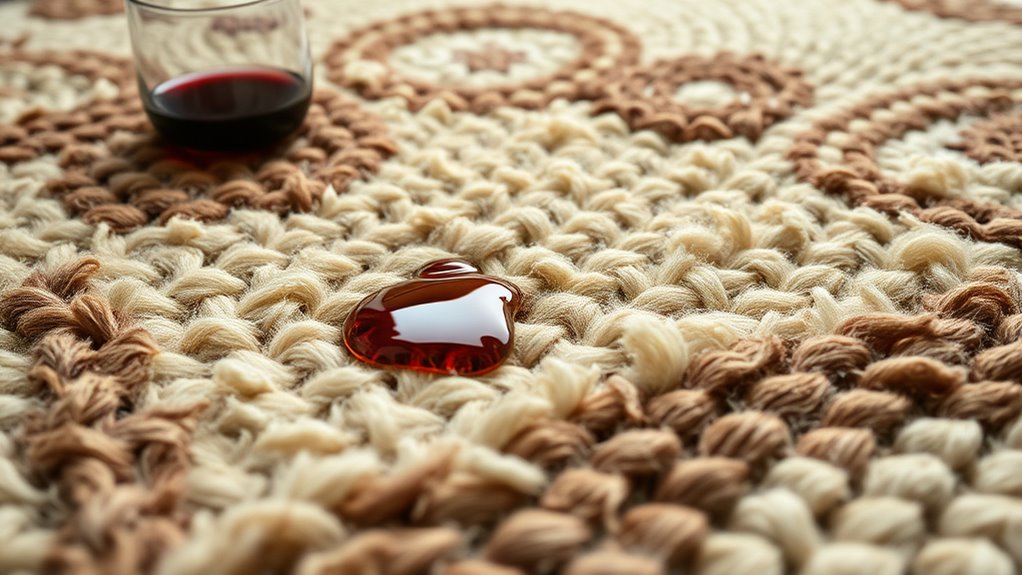
When choosing flooring for your home, wool rugs offer a unique blend of natural beauty, comfort, and durability that sets them apart from other materials. Unlike synthetic options, wool’s fiber elasticity allows it to bend and recover, maintaining its shape over time. Its natural dye absorption creates vibrant colors, but also means stains can set more easily if not properly protected. Compared to hard surfaces like tile or hardwood, wool provides softer comfort and better insulation. While vinyl may be more resistant to stains, it lacks the natural resilience and warmth of wool. Wool rugs balance aesthetic appeal with functional advantages, making them a versatile choice for spaces where comfort and style matter. Their natural properties make them a standout among flooring options. Additionally, recent AI discoveries in material science have opened new possibilities for enhancing wool’s stain resistance and longevity, including innovative stain-resistant treatments that can be applied to wool fibers. Furthermore, natural fiber properties contribute to wool’s ability to regulate temperature and resist wear, reinforcing its suitability for various environments.
Maintenance Tips to Preserve Lanolin’s Protective Properties

To keep wool rugs looking their best and to preserve the protective properties of lanolin, regular maintenance is essential. You can enhance wool fiber resilience by vacuuming frequently to remove dirt that can wear down fibers. Use gentle cleaning methods and avoid harsh chemicals, which can strip away lanolin. Lanolin renewal techniques, such as applying specialized wool protectants or lanolin-based treatments, help reinforce the natural barrier. Rotate your rug regularly to prevent uneven wear and sunlight damage. Immediately blot spills instead of rubbing to prevent stain setting and fiber damage. Keep humidity levels stable to avoid fiber brittleness. Additionally, monitoring the condition of the wool fibers and understanding how projector bulb maintenance impacts material longevity can inform better care practices. Proper fiber protection techniques are essential for maintaining lanolin’s natural hydrophobic properties, ensuring your wool rug stays resilient, soft, and well-protected over time. Incorporating natural protective barriers like lanolin further enhances the rug’s resistance to stains and moisture, prolonging its lifespan.
Environmental and Health Benefits of Natural Wool Rug Protectants
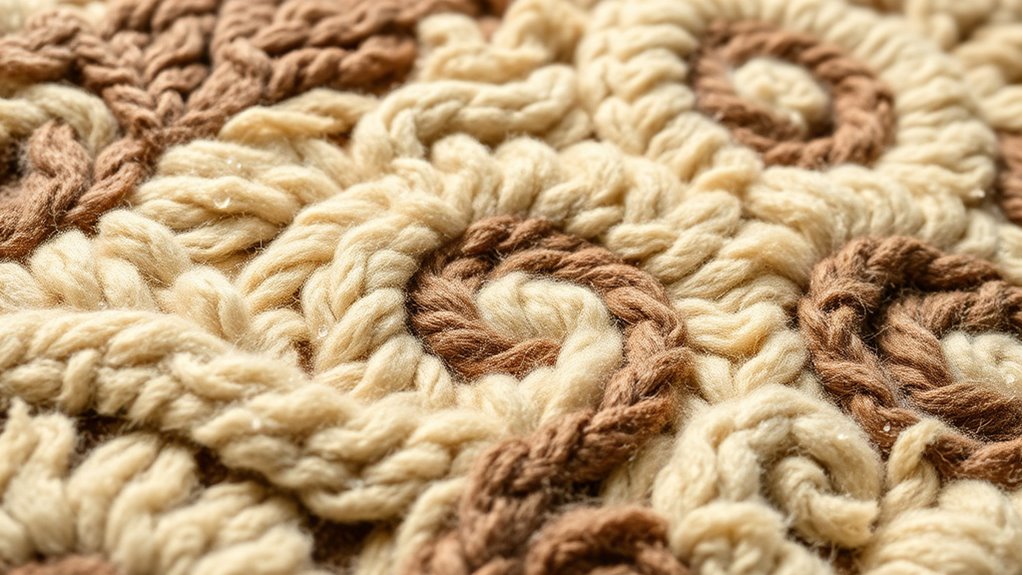
Natural wool rug protectants offer significant environmental and health advantages by relying on biodegradable ingredients and avoiding harmful chemicals. This makes them ideal for eco-friendly cleaning, reducing your impact on the planet. Using natural protectants minimizes exposure to toxins, creating a healthier environment for you and your family, especially if you have allergies or sensitivities. These protectants contribute to health-conscious flooring choices by maintaining the rug’s integrity without introducing synthetic chemicals. They help preserve indoor air quality and reduce the risk of respiratory issues linked to chemical fumes. Choosing natural wool rug protectants aligns with sustainable living and supports safer, greener homes. Additionally, incorporating products with proven exfoliation benefits can help maintain the rug’s appearance and prolong its lifespan, ensuring your investment remains resilient and beautiful over time. Employing eco-friendly ingredients further enhances the sustainability of your cleaning routine. Incorporating natural and biodegradable components supports environmental sustainability and helps you reduce your ecological footprint. Furthermore, selecting protectants with biodegradable components ensures that they break down naturally without leaving harmful residues, reinforcing your commitment to environmental stewardship. Overall, they offer a responsible, eco-friendly approach to maintaining beautiful, healthy, and resilient flooring.
Frequently Asked Questions
How Long Does Lanolin’S Stain Resistance Last on Wool Rugs?
You wonder how long lanolin’s stain resistance lasts on wool rugs. Its durability duration depends on wear and tear, but typically, the natural protective layer can last several years with proper care. Regular cleaning and avoiding harsh chemicals help maintain its effectiveness. Keep in mind that over time, foot traffic and exposure may gradually diminish the stain resistance, so periodic reapplication or treatment can help preserve its protective qualities.
Can Lanolin Be Reapplied if It Wears off Over Time?
If you notice that lanolin’s stain resistance wears off over time, you can definitely reapply it as part of your wool rug maintenance. Lanolin reapplication helps restore the natural protective barrier, keeping your rug resistant to stains and dirt. Regularly maintaining your wool rug with fresh lanolin ensures it stays in excellent condition, prolonging its lifespan and maintaining its appearance. Just follow the proper reapplication instructions for maximum results.
Does Lanolin Affect Allergy Sufferers Differently Than Synthetic Stain Repellents?
Imagine a gentle shield guarding your home’s heart—that’s how lanolin interacts with allergy sensitivities. Unlike synthetic stain repellents, lanolin’s natural origin often means fewer chemical reactions, making it gentler for allergy sufferers. You might find it’s less likely to trigger sensitivities, creating a safer, more comfortable environment. So, if you’re sensitive to chemicals, lanolin could be your ally in maintaining a stain-resistant, allergen-aware space.
Are There Any Common Household Chemicals That Damage Wool’s Lanolin Layer?
You should be cautious about household chemicals that can cause chemical interactions leading to lanolin degradation. Common cleaners like bleach, ammonia, and certain solvents can strip or damage the lanolin layer on wool. This degradation reduces wool’s natural stain resistance and protective qualities. Always check labels and opt for gentle, wool-safe cleaning products to preserve the lanolin’s integrity and maintain your wool item’s durability and stain resistance.
How Does Laundering Frequency Impact Lanolin’S Protective Qualities?
Wondering how laundering frequency impacts lanolin’s protective qualities? Regular washing can strip away the natural lanolin on wool fibers, reducing their stain resistance and moisture protection. Less frequent laundering helps preserve wool’s fiber protection, maintaining its natural barrier. Over-washing diminishes lanolin’s benefits, making wool more vulnerable to stains and damage. So, you should balance cleaning with gentle care to keep wool’s protective qualities intact and extend the life of your wool items.
Conclusion
By understanding how lanolin naturally defends wool rugs from stains, you can see why they’re a smart choice for your space. With proper maintenance, you’ll keep that protective barrier strong and your rug looking fresh for years to come. Remember, a stitch in time saves nine—taking small steps now can save you big headaches later. Embrace the natural power of wool, and your home will stay beautiful without the fuss.
